Imagine stepping out into your backyard on a warm summer evening, greeted by a symphony of fragrant blossoms that have unfurled their petals under the enchanting glow of the moon. This ethereal experience is made possible by the captivating world of night-blooming flowers – nature’s nocturnal beauties that bloom when the rest of the garden has retired for the night.
In this article, we’ll explore an enchanting journey through the fascinating realm of night-blooming flowers, their unique characteristics, their diverse species, and how you can incorporate these mesmerizing blooms into your Australian home improvement projects. Get ready to embrace the magic of a garden that comes alive when the sun goes down!
Key Takeaways:
- Night-blooming flowers have evolved to thrive in the darkness, offering a unique and captivating experience for gardeners and nature enthusiasts.
- These nocturnal beauties boast an array of unique features, from enticing fragrances to striking colors and shapes that stand out against the night sky.
- Incorporating night-blooming flowers into your Australian home improvement projects can create a magical and sustainable environment that supports local pollinators and enhances the overall beauty of your outdoor spaces.
As the sun dips below the horizon and the world around you grows quiet, a secret garden awakens, revealing its hidden wonders to those who venture out under the cloak of night. This enchanting realm is home to a diverse array of night-blooming flowers, each with its unique charm and allure.
Introduction to Night-Blooming Flowers
Night-blooming flowers, as the name suggests, are a remarkable group of plants that have evolved to open their petals and release their intoxicating fragrances during the evening hours. These botanical marvels have adapted to this nocturnal lifestyle to attract specific pollinators, such as moths and bats, that are active at night.
Beyond their captivating blooms and alluring scents, night-blooming flowers offer a host of unique features that set them apart from their diurnal counterparts. Many of these flowers boast large, white, or pale-colored petals that stand out against the darkness, making them more visible to their nocturnal pollinators. Additionally, some species emit a subtle glow or have temperature-regulating mechanisms to entice their visitors.
Flowers That Bloom at Night
Here are the top 15 flowers that bloom at night, along with their characteristics, growing conditions, and benefits in gardens.
1. Moonflower (Ipomoea alba)

- Characteristics: Large, fragrant, white blooms that unfurl as the sun sets, can reach up to 6 inches in diameter.
- Growing Conditions: Thrives in warm climates (USDA Hardiness Zones 9-11), prefers well-draining soil and full sun to partial shade.
- Benefits in Gardens: Creates a romantic and enchanting atmosphere, and can be grown as vines for vertical interest.
2. Night Phlox (Zaluzianskya ovata)
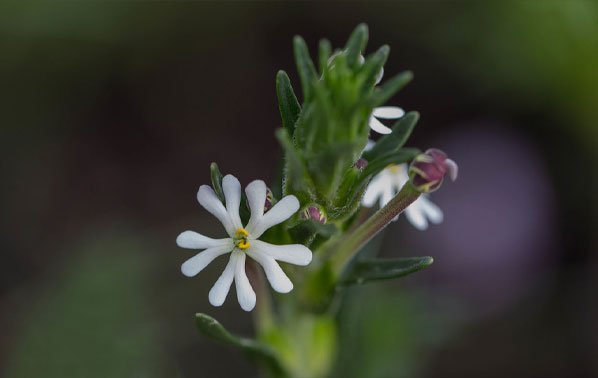
- Characteristics: Delicate white or pale pink blooms with a sweet, jasmine-like scent.
- Growing Conditions: Hardy plant (USDA Hardiness Zones 5-9), prefers well-draining soil and full sun to partial shade.
- Benefits in Gardens: Adds color and fragrance in the evening, suitable for borders, rock gardens, or containers.
3. Evening Primrose (Oenothera)
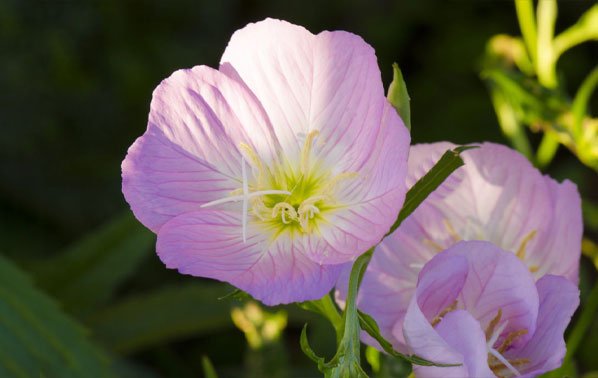
- Characteristics: Delicate yellow or white blooms that open up as the sun sets, short-lived but abundant.
- Growing Conditions: Hardy plant (USDA Hardiness Zones 4-9), prefers well-draining soil and full sun to partial shade.
- Benefits in Gardens: Creates a natural and whimsical look in garden beds or meadows, and attracts pollinators.
4. Casa Blanca Lily (Lilium ‘casa blanca’)
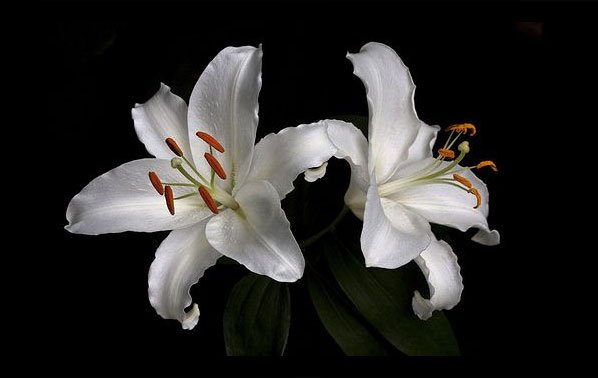
- Characteristics: Large, fragrant white blooms that can reach up to 8 inches in diameter, emits a heavenly scent.
- Growing Conditions: Thrives in USDA Hardiness Zones 4-8, prefers well-draining soil and full sun to partial shade.
- Benefits in Gardens: Adds height and drama to outdoor spaces, and can be planted in borders, containers, or mixed beds.
5. Queen of the Night Cactus (Cereus hildmannianus)
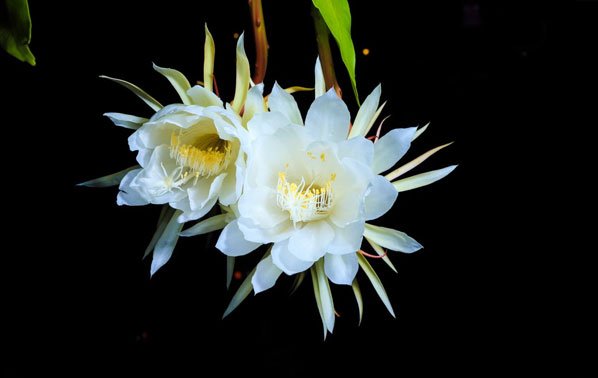
- Characteristics: Large, fragrant white blooms that open for just one night, can reach up to 12 inches in diameter.
- Growing Conditions: Thrives in USDA Hardiness Zones 9-11, prefers well-draining soil and full sun.
- Benefits in Gardens: Unique and captivating addition to desert-inspired landscapes or container gardens.
6. Kadupul Flower (Epiphyllum oxypetalum)
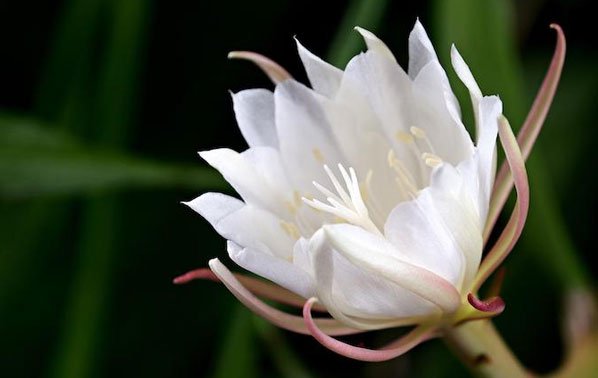
- Characteristics: Large, fragrant white flower with intricately arranged spiral petals, blooms for a single night.
- Growing Conditions: Thrives in warm, humid climates (USDA Hardiness Zones 9-11), prefers well-draining soil and partial shade to full sun.
- Benefits in Gardens: Offers a unique and enchanting experience, and attracts specific pollinators like hawk moths and bats.
7. Datura (Datura species)
- Characteristics: Large, trumpet-shaped flowers in white, yellow, or purple hues, with a strong fragrance.
- Growing Conditions: Thrives in warm climates (USDA Hardiness Zones 8-11), prefers well-draining soil and full sun.
- Benefits in Gardens: Adds drama and fragrance to evening gardens, and attracts pollinators like moths and bats.
8. Angel’s Trumpet (Brugmansia species)
- Characteristics: Pendulous, trumpet-shaped flowers in shades of white, yellow, pink, or orange, with a strong fragrance.
- Growing Conditions: Thrives in warm climates (USDA Hardiness Zones 9-11), prefers well-draining soil and partial shade.
- Benefits in Gardens: Creates a tropical and exotic atmosphere, and attracts pollinators like moths and hummingbirds.
9. Night-Blooming Jasmine (Cestrum nocturnum)
- Characteristics: Clusters of small, greenish-white tubular flowers with an intense, sweet fragrance.
- Growing Conditions: Thrives in warm climates (USDA Hardiness Zones 9-11), prefers well-draining soil and full sun to partial shade.
- Benefits in Gardens: Adds fragrance to evening gardens, and can be grown as a hedge or in containers.
10. Night-Blooming Cereus (Hylocereus undatus)
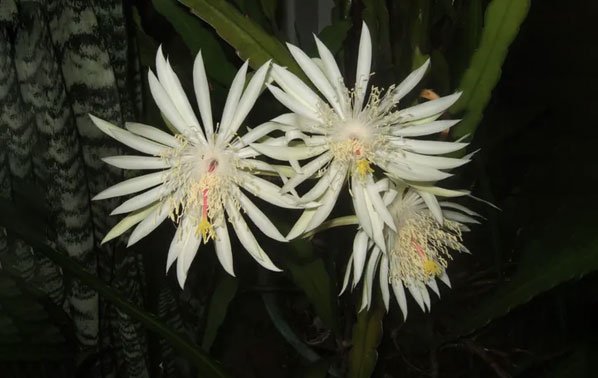
- Characteristics: Large, white, fragrant blooms that open at night and last for a single evening.
- Growing Conditions: Thrives in warm climates (USDA Hardiness Zones 9-11), prefers well-draining soil and full sun.
- Benefits in Gardens: Unique and spectacular addition to cactus or desert gardens, attracts pollinators.
11. Tuberose (Polianthes tuberosa)
- Characteristics: Clusters of waxy, white, tubular flowers with an intense, sweet fragrance.
- Growing Conditions: Thrives in warm climates (USDA Hardiness Zones 8-11), prefers well-draining soil and full sun.
- Benefits in Gardens: Adds fragrance to evening gardens, suitable for cutting and indoor arrangements.
12. Night-Blooming Jessamine (Cestrum nocturnum)
- Characteristics: Clusters of small, greenish-white tubular flowers with a sweet, jasmine-like fragrance.
- Growing Conditions: Thrives in warm climates (USDA Hardiness Zones 9-11), prefers well-draining soil and full sun to partial shade.
- Benefits in Gardens: Adds fragrance to evening gardens, and can be grown as a hedge or in containers.
13. Night-Blooming Water Lily (Nymphaea species)
- Characteristics: Large, fragrant white or pink blooms that open at night and close during the day.
- Growing Conditions: Requires a water feature or pond, prefers full sun and warm water temperatures.
- Benefits in Gardens: Adds beauty and fragrance to water features, and attracts pollinators like moths and bats.
14. Night-Blooming Cestrum (Cestrum nocturnum)
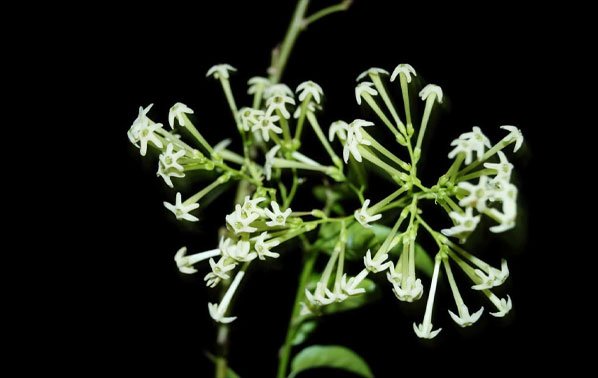
- Characteristics: Clusters of small, greenish-white tubular flowers with an intense, sweet fragrance.
- Growing Conditions: Thrives in warm climates (USDA Hardiness Zones 9-11), prefers well-draining soil and full sun to partial shade.
- Benefits in Gardens: Adds fragrance to evening gardens, and can be grown as a hedge or in containers.
15. Night-Blooming Cactus (Epiphyllum oxypetalum)
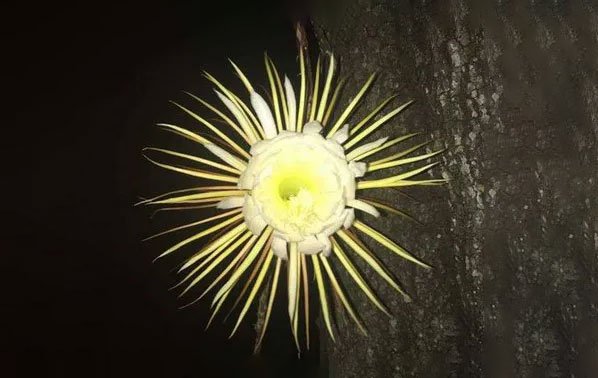
- Characteristics: Large, fragrant white or pink blooms that open at night and last for a single evening.
- Growing Conditions: Thrives in warm climates (USDA Hardiness Zones 9-11), prefers well-draining soil and partial shade.
- Benefits in Gardens: Unique and striking addition to cactus or succulent gardens, attracts pollinators.
How to Incorporate Night-Blooming Flowers into Your Australian Home Improvement
Incorporating night-blooming flowers into your Australian home improvement projects can add a touch of magic and enchantment to your outdoor spaces. Here are some tips to help you create a captivating moon garden:
Tips for Planting and Caring for Night-Blooming Flowers
- Choose a location that receives ample sunlight during the day and is visible from your outdoor living areas or pathways.
- Prepare the soil by mixing in well-rotted compost or manure to improve drainage and nutrient content.
- Water your night-blooming flowers deeply and consistently, especially during the hottest months of the year.
- Prune or deadhead spent blooms to encourage continued flowering throughout the season.
Designing a Moon Garden
Creating a dedicated moon garden is a wonderful way to showcase the beauty of night-blooming flowers. Here are some design tips:
- Incorporate seating areas or pathways that allow you to experience the garden at night.
- Use light-colored hardscaping materials, such as gravel or pale-colored pavers, to reflect the moonlight and create a soft, ethereal glow.
- Include water features, such as fountains or ponds, which can add a soothing ambiance and attract pollinators.
- Strategically place night-blooming plants near seating areas or along pathways for maximum impact.
Combining Night-Blooming Flowers with Other Plants
While night-blooming flowers are the stars of the show, you can enhance their beauty by combining them with other plants that complement their unique features. Here are some ideas:
- Plant silver-leaved or white-variegated plants, such as dusty miller or caladiums, to reflect the moonlight and create a luminous effect.
- Incorporate fragrant herbs or shrubs, such as lavender or jasmine, to add additional layers of scent to your evening garden.
- Include plants with interesting textures or shapes, such as ornamental grasses or succulents, to create visual interest and depth.
Benefits of Night-Blooming Flowers for Pollinators and the Environment
By incorporating night-blooming flowers into your Australian home improvement projects, you’re not only creating a magical and enchanting outdoor space but also contributing to the health and sustainability of local ecosystems. These flowers play a crucial role in supporting nocturnal pollinators, such as moths and bats, which are essential for maintaining biodiversity and promoting healthy plant communities.
Furthermore, many night-blooming flowers are native or well-adapted to local conditions, making them low-maintenance and water-efficient choices for Australian gardens. By choosing these plants, you’re creating a sustainable and eco-friendly outdoor space that requires fewer resources and chemical inputs.
Conclusion
Night-blooming flowers offer a unique and enchanting experience for gardeners and nature lovers alike. By incorporating these captivating blooms into your Australian home improvement projects, you can create a magical and sustainable environment that not only delights the senses but also supports local pollinators and the environment.
Imagine stepping out into your garden on a warm summer evening, greeted by the intoxicating fragrance of moonflowers and the ethereal glow of Casa Blanca lilies. As you stroll along the pathways, the enchanting blooms of the Kadupul flower unfurl, revealing their intricate spiral patterns and inviting you to witness the remarkable pollination process unfold.
With careful planning and thoughtful design, you can transform your outdoor spaces into a nocturnal paradise, where the beauty and wonder of night-blooming flowers take center stage. So, embrace the magic of these botanical marvels, and let their enchanting presence transport you to a realm of natural beauty and tranquility that comes alive when the sun goes down.
